国际商务谈判(英文)Course Description[精]
- 格式:ppt
- 大小:539.50 KB
- 文档页数:1
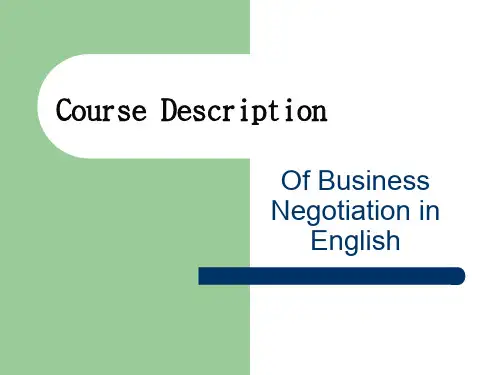

国际商务谈判一、性质与目的《国际商务谈判》(英)是英语专业的选修课程之一,也是一门兼具理论性与实用性的学科。
该课程是一门融英语基本知识、国际贸易实务学科、营销学科、公共关系学科为一体的边缘交叉学科,综合性、应用性强,在商务实践活动中居于非常重要的地位。
课程主要介绍商务谈判的有关知识、技巧和方法,具有知识面广、法律性强、实践性强、系统性强的特点。
通过本课的学习,要求学生掌握有关商务谈判内容和方法的基本知识,懂得商务谈判的有关法律规定,基本掌握商务谈判的程序及技巧,掌握商务谈判的策略及有关技能,平衡处理谈判过程中遇到的错综复杂的风险、策略、利益关系,为今后从事商务谈判工作打下良好的基础。
二、基本要求课程从经济贸易人员的实际需要出发,以具有代表性的商务谈判为重点,阐明有商务谈判的基础理论、基本知识以及商务谈判的基本技能。
学生必须先完成商务英语基本知识和国际经济与贸易的专业相关知识,才能更好的完成本课程的学习。
同时,通过学习本课程,可以巩固、提高以前所学知识,并促进后续其他课程的学习。
通过本课程学习,学生要能够熟悉商务谈判的概念、过程,理解商务谈判的原理,学会准备谈判,掌握国际上通行的谈判方法和技巧,了解掌握商务谈判中的各种策略。
本课程旨在帮助学生增强商务活动中的谈判能力,使学生能够利用商务谈判的方法和知识对实际商务活动,做出科学合理的商务谈判方案,并能够在实际谈判中应用自如,取得谈判成功。
三、教学内容及学时本课程32学时选用教材:《国际商务谈判》,刘白玉主编,中国人民大学出版社。
教学内容Basic Theories for International Business Negotiation1.case study2. basic theory: definition, win-win negotiation3.background information; oral practiceStaffing Business Negotiation1. case study2.background knowledge, practicePhases of International Business Negotiation1.case study2.the four phases of negotiation, conceptNegotiation Strategies and Tactics1.case study2.categories of strategies, practiceTypes of International Business Negotiationcase study2.sales or services negotiation, simulated negotiationVerbal and Nonverbal Communication Skillscase studynonverbal behaviors, and practiceInternational Business Etiquette1.case studybackground knowledge and practiceCross-Cultural Business negotiationcase studycross-cultural theories, review四、教学原则与方法讲授为主,在教学过程中辅之以讨论、案例分析、实务应用等。
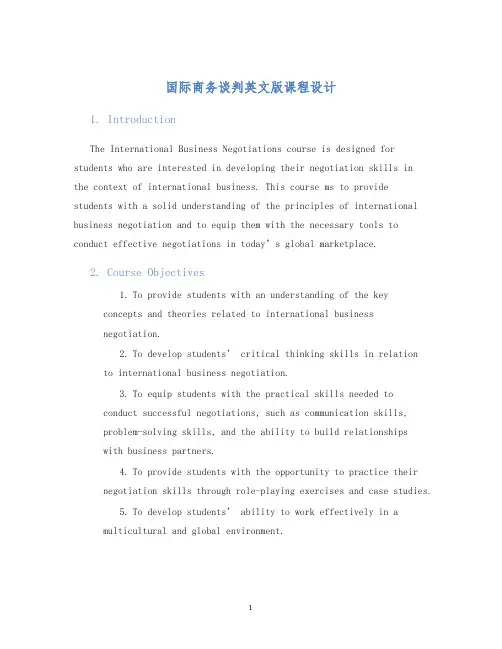
国际商务谈判英文版课程设计1. IntroductionThe International Business Negotiations course is designed for students who are interested in developing their negotiation skills inthe context of international business. This course ms to providestudents with a solid understanding of the principles of international business negotiation and to equip them with the necessary tools to conduct effective negotiations in today’s global marketplace.2. Course Objectives1.To provide students with an understanding of the keyconcepts and theories related to international businessnegotiation.2.To develop students’ critical thinking skills in relationto international business negotiation.3.To equip students with the practical skills needed toconduct successful negotiations, such as communication skills,problem-solving skills, and the ability to build relationshipswith business partners.4.To provide students with the opportunity to practice theirnegotiation skills through role-playing exercises and case studies.5.To develop students’ ability to work effectively in amulticultural and global environment.3. Course ContentWeek 1: Introduction to International Business Negotiation•Definition of international business negotiation•Cultural differences in negotiation•Types of negotiation and negotiation strategies Week 2: Preparation for International Business Negotiation•Identifying negotiation goals and objectives•Assessing the negotiation environment and the parties involved•Developing negotiation strategiesWeek 3: The Negotiation Process•Opening the negotiation•Bargning and making concessions•Closing the negotiationWeek 4: Communication Skills for International Business Negotiation •Active listening and questioning techniques•Persuasion and influence strategies•Nonverbal communication in negotiationWeek 5: Building and Mntning Relationships in International Business Negotiation•Importance of relationship-building in negotiation•Strategies for building trust and rapport with business partners•Mntning relationships after the negotiationWeek 6: Cross-cultural Negotiation•Cultural differences in negotiation styles and behaviors•Cultural dimensions and their impact on negotiation•Overcoming cultural barriers in negotiationWeek 7: Case Studies in International Business Negotiation •Analyzing case studies of international business negotiation •Identifying lessons learned and best practices•Applying negotiation concepts and strategies to real-world situationsWeek 8: Role-Playing Exercises in International Business Negotiation •Simulating negotiation scenarios in a classroom setting•Applying negotiation concepts and strategies to role-playing exercises•Receiving feedback on negotiation skills and areas for improvement4. Assessment1.Participation in class discussions and exercises (20%)2.Group project and presentation on a negotiation case study(30%)3.Individual reflective essay on negotiation skillsdevelopment (20%)4.Final examination (30%)5. ConclusionBy the end of the International Business Negotiations course, students will have gned a comprehensive understanding of the principles and practice of negotiation in the context of international business. They will have developed their negotiation skills through practical exercises and case studies, and will be equipped with the knowledge and tools to conduct successful negotiations in today’s global marketplace.。

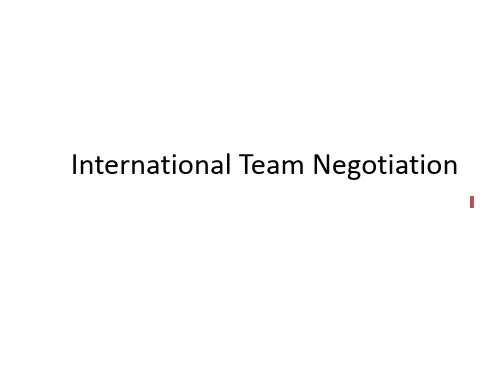

《国际商务谈判(双语)》课程教学大纲【International Business Negotiation】Syllabus一、课程的性质与任务(一)本课程的性质该课程面向工商管理、国际经济与贸易、物流管理等专业,理论教学联系实践应用,属于专业必修课。
(二)本课程的任务该课程在专业培养计划中占据重要地位,实用价值很强,对于走向商业性岗位的大专毕业生来说,学习主要的议价和谈判心理学,以及人与人之间、团体之间的冲突。
介绍谈判方法,对于那些想要感受谈判艺术的人们来说是一个完全独立的学习渠道。
现实生活中,人们无时无刻不在谈判,它几乎是每个人每天都要做的事情。
谈判能力的培养与获得,涉及生活工作的方方面面,需要一定的经验,同时也要以必需的理性认识为基础。
在专业课程里属一般课程。
该课程侧重理论和技能培养两者并重、相互结合。
二、课程的基本要求通过案例和理论相结合的学习,达到使学生理解并运用谈判策略、技巧和谈判艺术的目的。
学生将初步具有用国际商务谈判知识解决一般问题的能力,对在谈判中出现的各种情况具有一定的分析能力和解决问题的能力,自身的素质得到一定的提升,拥有一定的对外交往的实际能力。
引入“头脑风暴”式教学互动模式,提高学生的表达能力、沟通能力、组织合作能力和应变能力。
三、课程内容(一)课程主要内容第1章 谈判的本质教学内容:1.1 乔和休·卡特1.2 谈判情形的特征1.3 相互依赖1.4 相互调整1.5 价值主张和价值创造1.6 冲突1.7 有效的冲突管理能力要求:知道:谈判情形的特征;理解:谈判中双方的相互依赖,价值主张和价值创造;分析:谈判中双方的相互调整;综合:有效的冲突管理。
教学重点:谈判中双方的相互依赖和相互调整 价值主张和价值创造 有效的冲突管理。
第2章 对立型谈判的战略与战术教学内容:2.1 对立型谈判情形2.2 战术型任务2.3 谈判中所持立场2.4 承诺2.5 结束谈判2.6 强硬战略2.7 对立型谈判策略适用于合作型谈判能力要求:知道:对立型谈判概念,谈判中所持立场的含义;理解:战术型谈判任务,谈判中的承诺;运用:强硬战略的运用时机。
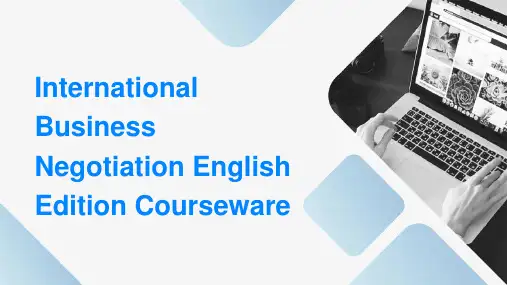
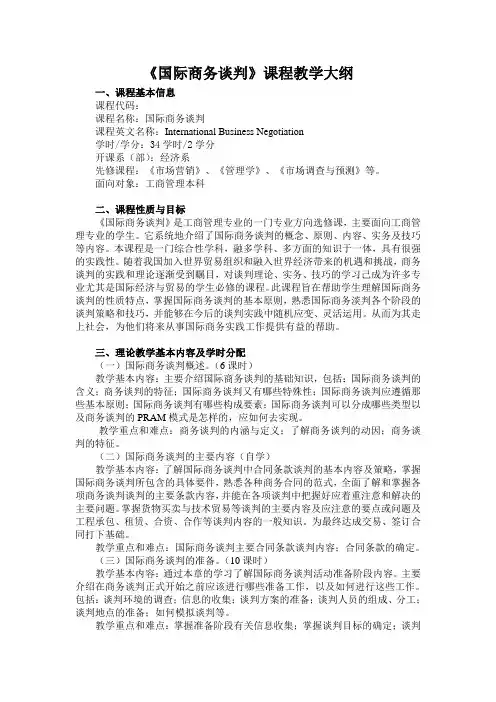
《国际商务谈判》课程教学大纲一、课程基本信息课程代码:课程名称:国际商务谈判课程英文名称:International Business Negotiation学时/学分:34学时/2学分开课系(部):经济系先修课程:《市场营销》、《管理学》、《市场调查与预测》等。
面向对象:工商管理本科二、课程性质与目标《国际商务谈判》是工商管理专业的一门专业方向选修课,主要面向工商管理专业的学生。
它系统地介绍了国际商务谈判的概念、原则、内容、实务及技巧等内容。
本课程是一门综合性学科,融多学科、多方面的知识于一体,具有很强的实践性。
随着我国加入世界贸易组织和融入世界经济带来的机遇和挑战,商务谈判的实践和理论逐渐受到瞩目,对谈判理论、实务、技巧的学习己成为许多专业尤其是国际经济与贸易的学生必修的课程。
此课程旨在帮助学生理解国际商务谈判的性质特点,掌握国际商务谈判的基本原则,熟悉国际商务淡判各个阶段的谈判策略和技巧,并能够在今后的谈判实践中随机应变、灵活运用。
从而为其走上社会,为他们将来从事国际商务实践工作提供有益的帮助。
三、理论教学基本内容及学时分配(一)国际商务谈判概述。
(6课时)教学基本内容:主要介绍国际商务谈判的基础知识,包括:国际商务谈判的含义;商务谈判的特征;国际商务谈判又有哪些特殊性;国际商务谈判应遵循那些基本原则;国际商务谈判有哪些构成要素;国际商务谈判可以分成哪些类型以及商务谈判的PRAM模式是怎样的,应如何去实现。
教学重点和难点:商务谈判的内涵与定义;了解商务谈判的动因;商务谈判的特征。
(二)国际商务谈判的主要内容(自学)教学基本内容:了解国际商务谈判中合同条款谈判的基本内容及策略,掌握国际商务谈判所包含的具体要件,熟悉各种商务合同的范式,全面了解和掌握各项商务谈判谈判的主要条款内容,并能在各项谈判中把握好应着重注意和解决的主要问题。
掌握货物买卖与技术贸易等谈判的主要内容及应注意的要点或问题及工程承包、租赁、合资、合作等谈判内容的一般知识。
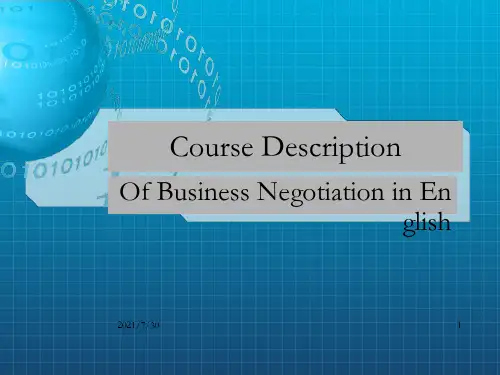

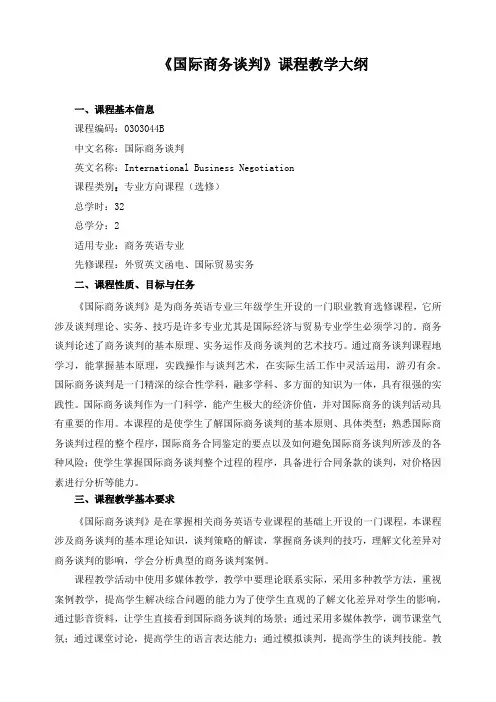
《国际商务谈判》课程教学大纲一、课程基本信息课程编码:0303044B中文名称:国际商务谈判英文名称:International Business Negotiation课程类别:专业方向课程(选修)总学时:32总学分:2适用专业:商务英语专业先修课程:外贸英文函电、国际贸易实务二、课程性质、目标与任务《国际商务谈判》是为商务英语专业三年级学生开设的一门职业教育选修课程,它所涉及谈判理论、实务、技巧是许多专业尤其是国际经济与贸易专业学生必须学习的。
商务谈判论述了商务谈判的基本原理、实务运作及商务谈判的艺术技巧。
通过商务谈判课程地学习,能掌握基本原理,实践操作与谈判艺术,在实际生活工作中灵活运用,游刃有余。
国际商务谈判是一门精深的综合性学科,融多学科、多方面的知识为一体,具有很强的实践性。
国际商务谈判作为一门科学,能产生极大的经济价值,并对国际商务的谈判活动具有重要的作用。
本课程的是使学生了解国际商务谈判的基本原则、具体类型;熟悉国际商务谈判过程的整个程序,国际商务合同鉴定的要点以及如何避免国际商务谈判所涉及的各种风险;使学生掌握国际商务谈判整个过程的程序,具备进行合同条款的谈判,对价格因素进行分析等能力。
三、课程教学基本要求《国际商务谈判》是在掌握相关商务英语专业课程的基础上开设的一门课程,本课程涉及商务谈判的基本理论知识,谈判策略的解读,掌握商务谈判的技巧,理解文化差异对商务谈判的影响,学会分析典型的商务谈判案例。
课程教学活动中使用多媒体教学,教学中要理论联系实际,采用多种教学方法,重视案例教学,提高学生解决综合问题的能力为了使学生直观的了解文化差异对学生的影响,通过影音资料,让学生直接看到国际商务谈判的场景;通过采用多媒体教学,调节课堂气氛;通过课堂讨论,提高学生的语言表达能力;通过模拟谈判,提高学生的谈判技能。
教学中,通过课堂讨论、案例分析提高学生语言表达能力的培养,采取灵活多边的教学方法和模式,增加讨论分析课时。
《国际商务谈判课程》教学大纲课程名称:国际商务谈判课程编号: 11153002 英文课程名称:International Business Negotiations适用专业:国贸,金融,经济总学时数:30 学分数:2理论教学时数:10 实验(实践)教学时数:20 执笔人:黄伟编写日期:2017年2月一、课程性质与任务《国际商务谈判》是国际经济与贸易专业的专业基础课程,融多学科、多方面的知识于一体,具有很强的实践性、操作性的课程。
该门课程的主要教学任务是以人才培养与社会需求相适应为核心,强化理论与实践相结合,通过本课程理论和试验课程学习,使学生掌握并运用国际商务谈判策略、技巧、跨文化沟通能力,以实现以“知识、能力、素质”交融培养和“厚基础、强特色、重创新”为课程培养目标。
二、课程教学目标1.通过本课程的学习,了解国内外经典的谈判理论,包括谈判产生的原因、谈判结构、双赢理念、合作原则谈判法、谈判力、利益分配法则、信任法则、博弈论在谈判中的应用、两分法谈判与复杂谈判、谈判个人心里和文化背景等,能运用基本理论和实例对影响谈判全过程的主要因素进行全面分析。
2.结合理论部分内容进行具有典型性和普遍性的案例分析,使其更好地服务于理论的讲解,培养学生认识问题、分析问题和解决问题的能力。
3.通过网络谈判教学让学生运用先进教学设备和技术手段,及时查找就商务谈判相关前沿发展现状和趋势,了解贸易谈判中的相关新政策等信息。
4.学生在模拟谈判整个过程中(谈判前、谈判中和谈判后)可以依据真实案例比较实际谈判的结果和自己谈判的结果,获得比较接近实际的真实体验,培养学生具有良好的品德修养、较强的语言表达能力、沟通能力、熟练运用外语进行跨文化交流能力,具有综合不同学科知识解决实际问题的能力、独立思考的能力和创新思维的能力和团队合作能力。
三、课程教学内容、要求及学时分配1.理论教学Chapter I An Overview of IBN one class hour Section I Concept and characteristics of international business negotiation Section II Principles of Business NegotiationSection III The types of international business negotiationSection IV Form & Approaches of Business CommunicationKey point: Negotiations are a struggle of wits and capabilities as well as a chase of strategy and skills. Under the circumstance of market economy, business negotiations covering everywhere and any time can contribute to a significant impact on companies’ survival and development.The corresponding course teaching objectives:1Chapter II The theories of international business negotiation one class hour Section I The Economic theorySection II The Basic Psychological Theory of Business NegotiationSection III Integrative approach and win-win principleSection IV Game theory and the principle of good faithKey point: The models with the theory of comparative advantage and the theory of reciprocal demand are widely used to ensure the price of trade. The models of the theory of trade mainly shows why international trade happens and whether the profit distribution in trade is balanced or not.Difficult point: conceptThe corresponding course teaching objectives:1Chapter III Personnel quality, psychological and the group composition of International Business one class hour Section I psychology in International business negotiationSection II Individuals’psychological activities during the international business negotiationsSection III The qualities negotiators should possessSection IV Groups composition of international business negotiationKey point: This chapter shows Maslow’s Hierarchy of Needs, pointing out 5 degrees of people’s need, extending the business negotiation theory and its different uses in business negotiations, and explains the relations between ability and negotiations, qualities and negotiations and introduces different kinds of qualities and finally analyzes the features and divisions of the negotiations groups.The corresponding course teaching objectives:1Chapter IV Differences of Culture in International Business Negotiationsone class hour Section I Cultural factors affecting the style of business negotiationsSection II Cultural differences on international business negotiationSection III The business negotiation customs and styles in the prime regionKey point: The cultural differences have different influence in business negotiation. Cultural factors in negotiation style and cultural difference will have impacts on negotiation. It deals with the way to treat cultural differences in negotiation.The corresponding course teaching objectives:1Chapter V Preparations for Business Negotiations one class hour Section I The Preparations of Business NegotiationsSection II The Information Preparation for Business NegotiationsSection III Business negotiation plansSection IV Simulated NegotiationKey point: Preparation of negotiators is to set up a team, which includes the scale of the negotiation team, the quality of negotiators which should be possessed by the negotiators and division cooperation between group members and so on. The information collection is to better understand each other’s intentions, to make proper plans and negotiation tactics, strategies and the basic premise.The corresponding course teaching objectives:1Chapter VI Business Negotiation Strategies one class hour Section I Strategies of Starting StagesSection II Strategies of offerSection III Strategy of consultation stageSections IV Strategies on the Stage of Striking a BargainingKey point: Business negotiation strategy is generic terms of approaches, measures, techniques, tactics, tools and combinations of general application to achieve a specific goal in the process of business negotiations.The corresponding course teaching objectives:1Chapter VII Communication Skills in Business Negotiations one class hourSection I Sound Language in Business NegotiationSection II The silent Language in Business NegotiationSection III Word processing in business negotiationKey point: All the languages used can fall into two categories: verbal language and non-verbal language, language, the bridge in negotiation is the primary factor to success or failure for the negotiation. So how to use appropriately the skill of language is a major concern and consideration for the negotiators.The corresponding course teaching objectives:1Chapter VIII Different Forms of Tactics in Business Negotiationone class hour Section I Negotiation skills for the superiorSection II Negotiation skills for the inferiorSection III Negotiation skills for the balancedKey point: Choice and application of business negotiation tactics mostly depends heavily on the strong or weak strength of both sides. Exerting tactics expertly and skillfully is helpful to achieve the successful negotiation and reach objectives. The focus of this chapter is talking about the often-used negotiations skills for the negotiators in different position.The corresponding course teaching objectives:1Chapter IX Risk Aversion in International Business Negotiationone class hour Section I Analysis for the Risks of International Business NegotiationsSection II How to Forecast & Control Risks in International Business Negotiation Section III Methods to Avert RisksKey point: There are a wide range of complex factors that influence the success or failure of business activities. What we should make clear in international economic cooperation is that risks are difficult to be averted in business activities, we need to find chances to increase relatively stable return as well as to decrease the rates of causing different loss in the future.The corresponding course teaching objectives:1Chapter X Etiquette for International Business Negotiation one class hourSection 1 Summary for Etiquette in International Business NegotiationSection II Basic Business EtiquetteSection III Etiquette for International Business NegotiationKey point: Etiquette is the rules of international business negotiation if the communication processes violate the etiquette, it would not only undermine the feelings of both parties, but also affect the other aspects of yourself and evaluation, even lead to breakdown of the talks. So clearing the way for the smooth progress of negotiations is very important.The corresponding course teaching objectives:12. 实验教学:Experiment 1 2 class hours Liaoxi environmental industry park investmentⅠ. Experiment Aim:1. understand the process of business negotiation, including its concept, strategy and skill, psychological warfare spyware, how to solve the problem existed to put forward new solution.2. how to break deadlock during negotiation to promote win-win result.ⅡExperiment Theory1. Win-win Concept and Traditional Concept2. How can both sides win3. How to communicate with partner and solve the problem.Ⅲ. Experiment Content1. understand the process of Negotiation2. the characteristic of international negotiationⅣ. Experiment Demand1. each student learn the negotiation process2. offer how to handle and manage the win-win concept during the negotiationⅤ. Experiment Guidance1. Explain the structure of international negotiation according to the case.2. How can both sides get win-win result. Help students review the win-win theory.Experiment 2 2 class hoursThe office delay pay compensationⅠ. Experiment Aim:1.learn how to collect necessary information and locate the target decision2.form the staff negotiation teams3.choice of negotiation venuesⅡExperiment Theory1.Collaborative Principled Negotiation2.Invent Options for Mutual GainⅢ. Experiment Content1.Putting the above theory into the case2.Focus on Interests Not PositionsⅣ. Experiment Demand1.Prepare for the detailed data and material of the partner2.realize the programme prepared for the negotiation3.find out the shortage for each side during the process of negotiationⅤ. Experiment Guidance1.students are divided into several groups with four in each group, two students aresellers and the other two are buyers.2.continue the negotiation between two sides from where it stopped.3.the two students will discuss between themselves first and make decisions on finaloffer for the deal.Experiment 3 2 class hoursNegotiation on finance leaseⅠ. Experiment Aim:1.Team cooperation to overcome obstacle or weak point during negotiation2.put the theory into to the simulation practice and get the summary from thesimulationⅡExperiment Theoryw of interest Distribution2.Needs Theory3.Application of the Needs Theory in NegotiationⅢ. Experiment ContentAnalysis the background of seller and buyer, make out the outline for this case depending on the above theory, then try to apply to the case simulation.Ⅳ. Experiment Demand1.prepare to achieve a win-win result and apply in the negotiation2.analyze the interests of both parties and find out the common interests.3.if not reach an agreement with the other party, work out an options or alternatives. Ⅴ. Experiment GuidanceOrganize a group of 4 students. study the background materials for seller and the buyer respectively then discuss the key points to realize the finance lease.Experiment 4 2 class hoursAlteration of the right of distributionⅠ. Experiment Aim:1.Learn negotiation power and related factors2.Grasp application of power tactics3.Study factors causing the changes of negotiation powerⅡExperiment Theoryw of Trust2.Suggestions of Enhancing Mutual TrustⅢ. Experiment Content1.how to decide a person trusts and is trusted?2.Effects of Trust3.Determinants affecting a person’s trustful or mistrustful behaviorⅣ. Experiment Demand1.each group should discuss the background carefully to enhance trust one another2.analysis the secondhand market of cars and establish two at least plan fornegotiationⅤ. Experiment GuidanceWhatever each think will advance his interest, each side can introduce additional facts and assert opinions that would be plausible in this situation.Experiment 5 2 class hours Dispute on contract of purchase and sale of peanutⅠ. Experiment Aim:1.Learn the key theory and its application during negotiation2.Enhance further team cooperation and its flexibility during negotiationⅡExperiment TheoryGame Theory and Negotiation applicationⅢ. Experiment Content1.Study the organization structures of each group and understand the illustration ofGreen Bank Organization.2.to summarize the common interests and differences.3.to create and discuss new options and search for objective criteria.Ⅳ. Experiment Demand1.first group of students acting as a third party in the dispute between twodepartment managers, sales and product development, will help the other twoparties work out a solution themselves.2.the third group of students will explain his reason and if possible he may givemore of his own reasons as sales representative.Ⅴ. Experiment Guidance1.Two groups will be divided in this simulation. The first group act as a third party.The second group act as department managers and as product development.2.It is important for the second party to give his options and discuss with the otherparty in order for him to reach a solution acceptable to both sides with the help of the his own party.Experiment 6 2 class hoursSuspension of claimⅠ. Experiment Aim:1.Dealing with sales enquires2. Dealing with sales orders3. Negotiating a SaleⅡExperiment Theory1.Distributive Negotiation2.Price Negotiation and Negotiation ZoneⅢ. Experiment Content1.Study the case carefully then copy and complete the invoice with informationgiven during the conversation.2.Do the series exercises given depending on the situation points through internet. Ⅳ. Experiment Demand1.With very computer skill, the students must finish the exercises within given time.2.promoting the ability of listening and written language to enhance students’written negotiation ability.Ⅴ. Experiment Guidance1.grasp written outline and letter’s skill.2.finish the tasks with written language within given time in order to promotewriting skill.Experiment 7 2 class hoursSteel trade warehouse loansⅠ. Experiment Aim:1.Learn the definition of Culture2.Culture Patterns during negotiations around the WorldⅡExperiment Theory1.Involvement of Third Parties2.Coalition, Multi-party NegotiationⅢ. Experiment Content1.Learn Hi-tech and Technical Background nowadays by internet.2.Study the influence of Cross Culture to negotiation.Ⅳ. Experiment Demand1.Learn style of different countries’ culture and its function on negotiation2.promote your own adaptability to different culture around worldⅤ. Experiment GuidanceOrganize each side of 4 students for one group, assume that you are negotiators sent by Hi-tech. Follow the negotiation style guidelines but do not exaggerate them to the point of making them unrealistic. Discuss them with your team and plan how you will follow them in your negotiation.Experiment 8 2 class hours The joint venture of waste tire processing production baseⅠ. Experiment Aim:1.Learn the rule of joint venture and related factors2.Grasp application of power tactics3.Study factors causing the changes of negotiation powerⅡExperiment Theoryw of Trust2.Suggestions of Enhancing Mutual TrustⅢ. Experiment Content1.how to decide a person trusts and is trusted?2.Effects of Trust3.Determinants affecting a person’s trustful or mistrustful behaviorⅣ. Experiment Demand1.Each group should discuss the background carefully to enhance trust one another2.Analysis the market of waste tire and establish outline at least plan for negotiationⅤ. Experiment GuidanceWhatever each think will advance his interest, each side can introduce additional facts and assert opinions that would be plausible in this situation.Experiment 9 2 class hoursExport payment settlementⅠ. Experiment Aim:1.Application for the payment under the knowledge of payment terms2.Grasp application of payment tactics3.Study factors causing the changes of negotiation powerⅡExperiment Theoryw of International Trade2.Suggestions of Enhancing Mutual TrustⅢ. Experiment Content1.adjust the contract of business trade for export payment settlement2.win-win resultⅣ. Experiment Demand1.each group should discuss the background carefully to enhance trust one another2.analysis the secondhand market of cars and establish two at least plan fornegotiationⅤ. Experiment GuidanceWhatever each think will advance his interest, each side can introduce additional facts and assert opinions that would be plausible in this situation.Experiment 10 2 class hoursRelocation compensationⅠ. Experiment Aim:1.To overcome obstacle or weak point under adjustment of location govenmentduring negotiation2.Each sides will get the satisfactory results for the compensationⅡExperiment Theoryw of real east2.Needs Theory3.Application of the Needs Theory in NegotiationⅢ. Experiment ContentAnalysis the background of each side, make out the outline for this case depending on the above theory, then try to apply to the case simulation.Ⅳ. Experiment Demand1.prepare to achieve a win-win result and apply in the negotiation2.analyze the interests of each parties and find out the common interests.3.if not reach an agreement one another, work out an options or alternatives.Ⅴ. Experiment GuidanceFollow the negotiation style guidelines but do not exaggerate them to the point of making them unrealistic. Discuss them with your team and plan how you will follow them in your negotiation.四、教学方法本门课程的教学方法:课堂讲授、案例讨论、模拟谈判、网络谈判及课外作业(通过网络平台学习参考文献、答疑,远程谈判)。
西京学院本科毕业设计(论文)外文资料翻译教学单位:经济系专业:国际经济与贸易(本)学号:0700090641姓名:王欢外文出处:《国际商务谈判》附件:1.译文;2.原文;3.评分表2010年11月1.译文译文(一)国际商务谈判是国际商务活动中,处于不同国家或不同地区的商务活动当事人为了达成某笔交易,彼此通过信息交流,就交易的各项要件进行协商的行为过程。
可以说国际商务谈判是一种在对外经贸活动中普遍存在的﹑解决不同国家的商业机构之间不可避免的利害冲突﹑实现共同利益的一种必不可少的手段。
国际商务谈判与一般贸易谈判具有共性,即以经济利益为目的,以价格为谈判核心。
因为价格的高低最直接﹑最集中的表明了谈判双方的利益切割,而且还由于谈判双方在其他条件,诸如质量﹑数量﹑付款形式﹑付款时间等利益要素上的得与失,在很多情况下都可以折算为一定的价格,并通过价格的升降而得到体现或予以补偿。
在国际买卖合同中价格术语包括单价和总价。
单价则是由计量单位,单价,计价货币以及贸易术语构成。
例如,一个价格术语可以这样来说:“每吨CIF伦敦1500美元包含3%佣金”。
总价格是合同中交易的总额。
在谈判过程中,应该由谁先出价,如何回应对方的报价,做出多少让步才适当,到最后双方达成都能接受的协议,整个这一过程被称之为谈判之舞。
通常情况下,谈判者的目标价位不会有重叠:卖方想为自己的产品或服务争取的价格,会高出买方愿意付出的价格。
然而,有时候谈判者的保留点却会相互重叠,也就是说大多数买方愿意付出的价格都会高于卖方可以接受的最低价格,在这种议价区间的前提下,谈判的最终结果会落在高于卖方的保留点而低于买方的保留点之间的某个点上。
议价区间可以为正数,也可以为负数。
在正议价区间,谈判者的保留点会互相重叠的,即买方愿意出的最高价格高于卖方可以接受的最低价格。
这意味着谈判者能达成协议的话,那么结果肯定在这个区间之内。
负议价区间可能根本不存在或是负数,这可能会造成花费巨大的时间来做一件毫无结果的协议,谈判者将会浪费时间成本。
《商务英语谈判》课程简介5篇第一篇:《商务英语谈判》课程简介《商务英语谈判》课程简介课程名称:商务英语谈判英文名称:Business English Negotiation总学时(含授课学时和实验学时):36先修课程:《国际贸易理论与实务》、《外贸函电》、《商务英语写作》、……。
内容简介:《商务英语谈判》是一门主要研究国际商务谈判具体过程及实务的课程,是一门实践性很强的综合性应用课程,是国际商务学科体系中的一门基础课程,也是商务英语专业的骨干支撑课程。
该课程针对国际商务谈判的特点和要求,从实践的角度,分析研究国际商务谈判相关的国际惯例和国际商品交换过程的各种实际运作,以从事国际商务谈判的主要业务环节为主线,系统介绍各环节的操作规程和国际惯例。
本课程科学地把商务知识、谈判知识、现代沟通的内容及形式与英语语言综合技能融为一体,目的在于帮助更多的学习者通过系统的商务英语谈判的学习,掌握商务谈判的基本理论知识,借助于灵活多变的谈判技巧,熟悉各种谈判活动,了解不同商务活动的人文背景、规范以及具体操作程序,从而提高商务谈判中分析问题和处理问题的能力,并使得学习者在英语应用能力的同时掌握商务英语专业知识,从而实现培养复合型人才的目标。
适用专业及层次:高等学校经济管理类和商务英语专业高年级学生必修专业课。
考核方式:模式商务谈判选用教材:蒋磊,《国际商务英语谈判与沟通》,高等教育出版社, 2007参考书目:1.余慕鸿等,《商务英语谈判》,外语教学与研究出版社, 20052.徐宪光,《商务沟通》,外语教学与研究出版社, 20013.金英,肖云南,《国际商务谈判》,清华大学出版社,20034.秦川,《商务英语谈判》,中国对外经济贸易出版社,2004第二篇:商务英语谈判Chapter 1 :1.Negotiation is the process we use to satisfy our needs when someone else control what we want.2.Different types in Theory and Practice:a)Competitive style: To try to gain all there is to gainb)Accommodative style(通融式谈判): To be willing to yield all there is to yieldc)Avoidance style: To try to stay out of negotiationd)Compromising style(妥协谈判): To try to split the difference or find an intermediatepoint according to someone principlee)Collaborative style(合作谈判): To try to find maximum possible gain for bothpartiesf)Vengeful style(报复谈判): harm the otherg)Self-inflicting style(自损谈判): harm oneselfh)Vengeful and self-inflicting style: harm the other and also oneself3.The goal of collaborative negotiation is to manage the dispute so that the outcome is more constructive than destructive.4.Principled negotiation is centered around four consideration(PIOC):a)People: separate the people from the problemb)Interests: focus on interests, not positionc)Options(选择): invent options for mutual gainsd)Criteria(条件): insist on using objective criteria5.Personal interests are interests of individuals whoparticipate in anizational interests are of collective bodies such as private or state-owned enterprises, institutions and other kinds of entities(实体)6.Case study: During the Cold War......against it.2)They followed the “National interests go before organizational interests.” principle第三篇:商务英语谈判Business NegotiationA: The seller Miss su representingKai ya Chocolate Manufacturing Co.LtdB: The buyer Mr.zhou representing zhong shang supermarket.A: Good morning, Mr.Zhou.Glad to meet you.B: Good morning, Miss su.It’s very nice to see you in person.A: How are things going?B: Everything is nice.A: So, what’s the topic of today’s meeting?B: Ok, after the last talk, we appreciate you price very much.Now let’s talk about the terms of payment.Would you accept D/P? I hope it will be acceptable to you.A: The terms of payment we usually adopt are sight L/C.B: But I think it would be beneficial to both of us to adopt more flexible payment terms such as D/P term.A: Payment by L/C is our usual practice of doing business with all customers for such commodities.I’m sorry we can’t accept D/P terms.B: As for regular orders in future, couldn’t you agree to D/P?A: Sure.After several smooth transactions, we can try D/P terms.B: Well, as for shipment, the soon the better.A: Yes, shipment is to be made in April, not allowing partial shipment.B: can you make it earlier? May be in March, our customer is eager for them.A: All right.Let me have a check, oh!There are somesteam vessels available to your port, so we can make it in March.B: Good!By the way, when can I expect to sign the S/C?A: Mr.Zhou, would it be convenient for you to come again tomorrow morning.I’ll get the S/C ready tomorrow for your signature.B: That’s fine.See you tomorrow.Goodbye.Miss Su.A: See you and thanks for coming, Mr.Zhou.第四篇:《剑桥商务英语》课程简介《剑桥商务英语(中级)》课程简介剑桥商务英语(中级)是一门以语言技能为主,商务技能为辅的融实践性、交际性为一体的语言课程。
国际商务谈判英文版一、国际商务的概念但是我与此同时我们更需要注意的是,这也是一个关于国际的商务谈判,其中就没有很好的运用我们上文中所提出的观点应该在谈判之前了解对方的文化,并且应该想好一旦迟到的情况下应该如何是好,如何地应对这种文化上的差异.接下来我们来看一下另一个事例,同样是面对这种迟到的情况,日本的谈判代表是如何做的:The Concept of International Business1. What Is Business?Traditionally, business simply meant exchange or trade for things people wanted or needed, but today it has a more technical definition, which is the production, distribution, and sale of goods and service for a profit. Business includes production, i.e. the creation of products or the offer of services, distribution, sale and profit. One good example is the conversion of iron ore into metal machine tool parts. The machine tools, made up of the various parts, need to be moved from a factory to a market place or a machine dealership, which is known as distribution. The sale means the exchange of goods or services for money. For example, a machine tool is sold to someone in exchange for money or a mechanic offers a service by repairing a machine tool for money, which we call sales.From the above, we can say, business is a combination of all these activities: production, distribution and sale, through which profit or economic surplus will be created. The major goal in functioning of any business company is to make profit, the money that remains after all the expenses are paid. So, creating profit or economic surplus is a primary goal of business activities.2. What Is International Business?International business as a field of management training deals with the special features of business activities that cross national boundaries. These activities may be movements ofgoods, services, capital, or personnel; transfers of technology, information, or data, or even the supervision of employees. International business has emerged as a separate branch of management training, because the growing scale and complexity of business transactions across national boundaries gives rise to new and unique problems of management and governmental policy that have received inadequate attention in traditional areas of business and economics.Business transactions that extend between different sovereign political units are not new phenomena on the world economic scene. Some business firms have had foreign direct investments and foreign operations for many years, predominantly in (but not limited to) the fields of mining, petroleum, and agriculture. Foreign trade, moreover, has a venerable history dating back to the emergence of the nation-state. But since the end of World War II a dramatic change has occurred in the patterns of international business activities. Thousands of business firms in many nations have developed into multinational enterprises with ownership control or other links that cross national boundaries. These firms take a global view of all aspects of business ---- from markets to resources ---- and they integrate markets and production on a world scale. Traditional international trade in the form of transactions between independent firms in different nations has continued to grow. But the relative importance of trade in the total picture has declined to other forms of cross-border business transactions which have expanded more rapidly.The international business field is concerned with issues facing international companies and governments in dealing with all types of cross border business transactions. The field encompasses international transactions in commodities,international transfers of intangibles such as technology and data, and the performance of international services such as banking and transportation. It gives special attention to the multinational enterprise ---- an enterprise based in one country and operating in one or more other countries ---- and the full range of methods open to such enterprises for doing business internationally.3. The Scope of International Business Activities谈判双方友好沟通;明确谈判目标;确定谈判人员;相关性地全面搜集资料,透彻分析目标关键,周全谈判计划,制定谈判战略;谈判地点选择,行程安排确定,翻译人员的决定,到达谈判地进行谈判;实质性谈判,体现谈判风格,运用谈判策略争取自身利益最大化(或共赢局态);协议的签订;谈判总结,成果汇报。